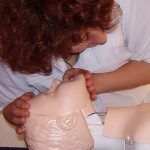If you or someone you know suffers an injury, it can be helpful to know some first aid basics.
Sprains and strains are common injuries affecting the muscles and ligaments and can occur in your ankle, foot, wrist, thumb, knee, leg or back.
Symptoms can include: pain, tenderness or weakness in the area; swelling or bruising; being unable to put weight on the injured limb and muscle spasms or cramping.
While most sprains and strains can be treated at home or by your pharmacist, you should visit A&E or call 999 if: you heard a crack when you had your injury; the injured body part has changed shape; if you feel numbness or if the affected area is discoloured or cold to touch.
RICE
RICE is a four step therapy for treating sprains and strains at home. The NHS recommends following the four steps of RICE for the first couple of days following a sprain or strain:
- Rest – stop any exercise or activities and try not to put any weight on the injury.
- Ice – apply an ice pack (or a bag of frozen vegetables wrapped in a tea towel) to the injury for up to 20 minutes every 2 to 3 hours.
- Compression – wrap a bandage around the injury to support it.
- Elevate – keep it raised on a pillow as much as possible.
They also recommend avoiding heat, such as hot baths or heat packs and that when you can move the injured area without pain stopping you, to try to keep moving it so the joint or muscle doesn’t become stiff.
However, if the injury doesn’t start to feel better once you have tried to treat it, if the pain or swelling is getting worse or if you develop a high temperature, you should seek advice from your GP or a minor injuries unit as soon as possible.
For more information about treating sprains and strains, visit: www.redcross.org.uk/first-aid/learn-first-aid/strains-and-sprains
Watch how to help someone who has a sprain or strain:





